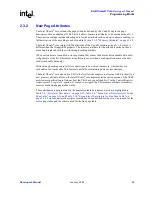
Developer’s Manual
January, 2004
37
Intel XScale® Core
Developer’s Manual
Memory Management
Memory Management
3
This chapter describes the memory management unit implemented in the Intel XScale
®
core.
3.1
Overview
The Intel XScale
®
core implements the Memory Management Unit (MMU) Architecture specified
in the ARM Architecture Reference Manual. To accelerate virtual to physical address translation,
the core uses both an instruction Translation Look-aside Buffer (TLB) and a data TLB to cache the
latest translations. Each TLB holds 32 entries and is fully-associative. Not only do the TLBs
contain the translated addresses, but also the access rights for memory references.
If an instruction or data TLB miss occurs, a hardware translation-table-walking mechanism is
invoked to translate the virtual address to a physical address. Once translated, the physical address is
placed in the TLB along with the access rights and attributes of the page or section. These translations
can also be locked down in either TLB to guarantee the performance of critical routines.
The Intel XScale
®
core allows system software to associate various attributes with regions of
memory:
•
cacheable
•
bufferable
•
line allocate policy
•
write policy
•
I/O
•
mini Data Cache
•
Coalescing
•
an ASSP definable attribute - P bit (Refer to the Intel XScale
®
core implementation section of
the ASSP architecture specification for more information.)
See
Section 3.2.2, “Memory Attributes” on page 3-38
for a description of page attributes and
Section 2.3.2, “New Page Attributes” on page 2-29
to find out where these attributes have been
mapped in the MMU descriptors.
Note:
The virtual address with which the TLBs are accessed may be remapped by the PID register. See
Section 7.2.13, “Register 13: Process ID” on page 7-91
for a description of the PID register.
















































